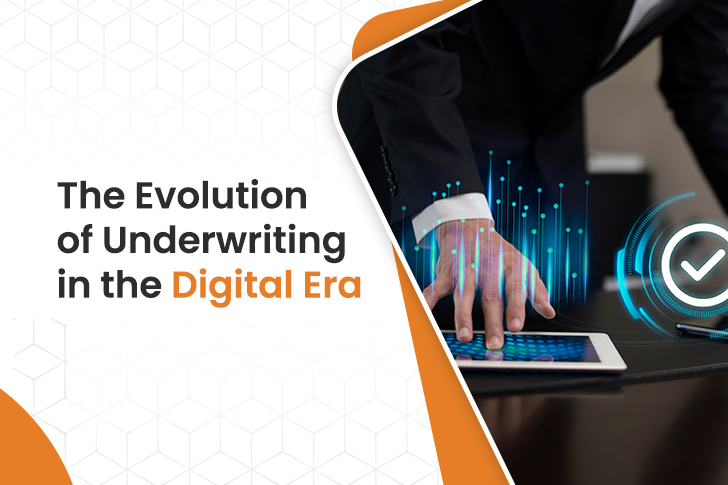Underwriting, a cornerstone for risk management in the dynamic world of finance and insurance, has proven essential in these industries. Born out of the maritime insurance sector, this centuries-old practice of insurance underwriting has undergone significant changes and is now on the brink of a digital revolution. Automation, cognitive technologies, and predictive analysis characterize the revolution. According to a survey by Deloitte, 55% of financial institutions now employ automated risk assessment methods in their insurance underwriting process, while 44% use AI and Machine Learning. The digital era promises to transform the traditional insurance underwriting process, making it faster, more accurate, and more efficient. This article will delve into the evolution of insurance underwriting in the digital era. It will explore the critical components of the traditional underwriting process, the transition to modern risk assessment, and the impact of digital technologies on the underwriting landscape.
A Brief Overview of the Traditional Underwriting Procedure
Underwriting, a concept originating from the 17th-century establishment of Lloyd’s of London, has since evolved into a critical process in various sectors such as insurance, loans, and equity markets. At its core, underwriting involves assessing risk and determining the appropriate premium for assuming that risk. For instance, in a sea voyage, underwriters would determine the likelihood of specific events (like a shipwreck) and then charge a fee, or premium, to cover that risk.
Crucial Components of the Traditional Underwriting Process
- Data Collection: Gather information about the applicant relevant to the type of insurance being applied for.
- Risk Assessment: Determine the likelihood of the applicant making a claim based on the collected data.
- Policy Pricing: Set the premium for the policy based on the assessed risk.
- Policy Decision: Decide whether to accept or reject the application or accept with specific exclusions.
- Documentation: Document the entire underwriting process and the final decision for future reference and compliance purposes.
This risk assessment process, a vital underwriting component, has significantly changed over time, shifting from traditional to more modern approaches.
Traditional Vs. Modern Risk Assessment
According to a survey by Deloitte in 2020, 55% of the respondent financial institutions use automation for risk assessment and 44% use cognitive technologies like AI and ML. Moreover, a report by McKinsey suggests that firms using AI and ML for risk assessment have seen a 10-25% increase in collections, a 50% reduction in model risk, and up to 20% reduction in capital costs.
The mentioned numbers clearly show how new risk assessment methods are slowly taking over traditional methods. The table below offers a detailed comparison of these two types of risk assessments, allowing our audience to evaluate the differing aspects based on various parameters.
| Traditional Risk Assessment | Modern Risk Assessment | |
| Basis | Relies on manual processes and human judgment. | It utilizes digital technologies like AI and machine learning. |
| Speed | More time-consuming. | Faster due to automation. |
| Volume | Limited by human capacity. | Can handle large volumes of data. |
| Accuracy | Prone to human error. | High accuracy due to automated processes. |
| Personalization | More personalized review of each application. | Standardized processes may overlook unique circumstances. |
| Scope | Limited to available and easily accessible data. | Can analyze vast and diverse data sources. |
| Flexibility | More flexibility with nuanced decisions. | Less flexible due to preset algorithms. |
Digitalization Sparks a Transformation in the Underwriting Landscape
According to a report by Deloitte, the use of predictive modeling in underwriting has increased from 20% in 2013 to 55% in 2017. This demonstrates that digitization enables insurers to predict risks and price policies better accordingly.
Digitalization is enhancing risk prediction accuracy in insurance underwriting, leading to revolutionary changes in the industry. Tools like big data analytics, AI, machine learning, and automation enable insurers to analyze large data volumes efficiently. This aids in accurate risk assessment, premium calculation, and informed decision-making. As digitalization progresses, these technologies emerge as game-changers, making the industry’s business model more efficient and effective.
Now, let’s explore how various techniques are transforming various underwriting processes
- Predictive Analytics for Risk Evaluation and Pricing: Predictive analytics uses statistical and machine-learning methods to analyze past and present data to forecast future events. Underwriting helps in accurate risk assessment and pricing of insurance policies. Decisions become more informed, and customer-specific pricing is possible.
- AI, Robotics, and Cognitive Automation: These technologies automate routine tasks, allowing underwriters to focus on complex tasks. AI hastens the underwriting process by automating data collection and analysis. Cognitive automation learns and adapts over time, thus improving risk assessment and pricing accuracy.
- Geo-based Information for Demographic and Location Data: Geo-based information systems provide demographic and location data, enhancing risk assessments. By analyzing this data, underwriters can identify potential risks associated with specific areas, leading to accurate risk evaluations and pricing.
- Big Data Capabilities for Data Amalgamation and Mining: Big data capabilities enable gathering and analyzing vast amounts of information. This allows underwriters to study comprehensive datasets for deeper insights and accurate predictions, leading to practical risk assessments and pricing strategies.
- IoT for Remote Data Collection and Monitoring: IoT devices enable remote data collection and monitoring, enhancing underwriting capabilities. Real-time tracking of a person’s health or a vehicle’s performance provides current information for risk assessments and pricing.
- Microservices and API-based System Integration: These technologies facilitate data exchange between software applications, allowing underwriters to access and analyze data from various sources, leading to comprehensive risk assessments and pricing strategies.
- Underwriting Workbench and Platform for Underwriters and Brokers: These digital platforms provide a centralized space for managing all aspects of the underwriting process, streamlining workflows, promoting collaboration, and providing real-time insights.
- Omni-channel Portal for Brokers and Customers: These portals provide a unified platform for the interaction and management of insurance policies, offering a seamless user experience and fostering stronger relationships between brokers, underwriters, and customers.
- Cloud and On-demand Infrastructure: This technology provides access to necessary resources and data anytime, anywhere, allowing underwriters to scale up or down based on demand, increasing efficiency and flexibility.
The Impact of Digital Transformation on the Future of Underwriting
Digital transformation, through tools like AI and ML, is revolutionizing underwriting by automating repetitive tasks, improving efficiency, and reducing human errors. This allows underwriters to focus on complex tasks, enhancing decision-making processes.
- Automation and Efficiency: AI, ML, and automation tools are used for task automation, reducing errors, and enhancing efficiency.
- Enhanced Risk Assessment: Big Data, predictive modeling, AI, and ML are used for real-time data analysis and accurate risk assessments.
- Personalized Policies: Detailed policyholder information collected using digital technologies allows for personalized underwriting.
- Improved Customer Experience: Digital transformation in underwriting leads to faster responses, more straightforward applications, and transparent communication.
- Fraud Detection and Prevention: Blockchain, AI, and ML are used to record transactions securely and prevent fraud.
- Data privacy, AI and ML algorithm regulation, and staff training are challenges.
Conclusion
In the digital era, underwriting has evolved significantly, leveraging AI, ML, big data, and predictive analytics for efficiency, accuracy, and customer-centricity. However, the complexities can be challenging. This is where outsourcing to experienced service providers like Insurance Backoffice Pro (IBOP) becomes beneficial. With expert underwriters and innovative solutions, IBOP provides tailored services, turning challenges into opportunities for success in the insurance industry. In conclusion, strategic underwriting through digital technologies and reliable outsourcing partners like IBOP is pivotal in today’s competitive landscape. Contact us today to revolutionize your underwriting process.







